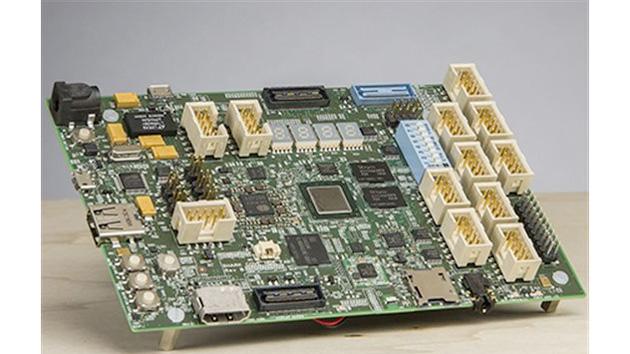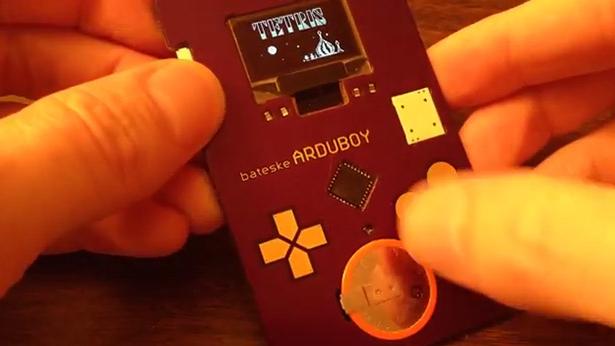arduino
Latest

Mod turns your graphing calculator into a selfie camera
Your graphing calculator may not be getting much use these days now that other mobile devices can do the job, but it still has a few tricks up its sleeve if you're willing to do some tinkering. Christopher Mitchell's latest project, ArTICam, lets you turn a TI-83 Plus or TI-84 Plus calculator into a selfie-oriented camera. The mod mostly requires a Game Boy Camera and a programmable Arduino board like the Uno. After a little bit of wiring and some (thankfully ready-made) code, you can snap self-portraits with a calculator command. The 128 x 123 grayscale pictures you take won't win photography awards, but that's not the point -- this is more about having fun with gadgets that might otherwise sit in the closet gathering dust. Hit the source link if you have the gear and want to give ArTICam a whirl. [Thanks, Christopher]

Game controller takes your real blood whenever you lose (update: suspended)
Forget playing games for cash -- if you really want to raise the stakes, try losing your actual blood when you lose in the virtual world. That's the concept behind Blood Sport, a crowdfunded project that modifies game controllers to drain your body when your character takes damage. Their Arduino-based technology turns a gamepad's rumble signals (which often indicate that you've been hit) into commands for a blood collection machine. In theory, every digital punch or gunshot draws some of the red stuff from your arm. And before you ask: Blood Sport limits transfers based on your age, medical conditions and weight, so you won't pass out just because your gaming skills aren't up to snuff.

Arduino sensors let ballerinas 'paint' with their pointes
What if you could paint with your shoes? Electronic Traces is a pair ballet pointe shoes that sends a dancer's movements to a nearby smartphone. Using Lilypad Arduinos, they record pressure and movement whenever they touch the ground. This data can then be visualized by an accompanying app, allowing dancers to view their performances after the fact, or compare them to others'.

NYC MoMA adds five maker devices to its permanent collection
If you've ever been to a Maker Faire, you know its as much of an art show as a technology showcase. Builders debut everything from robotic bands to educational circuitry kits at these events, and the NYC Museum of Modern Art is about to immortalize five maker products into its permanent collection. Early next year, the Arduino, Ototo, Makey Makey, Colour Chaser and a DIY Gamer Kit will be on display in the MoMA's design galleries, serving as representatives of the maker culture to the museum's visitors. MoMA is excited about the new additions, but it's not the first time technology has found its way into the museum's collection: in 2011 both Botanicalls and Little Bits found its way into MoMA's galleries. Check out the announcement at the source link below. [Image credit: NYC MoMA]

Student upgrades a 1930s typewriter for modern-day messaging
When people restore old typewriters, they mostly just make them (1) look new and (2) usable again. Joe Hounsham from Plymouth University in the UK, however, had other ideas in mind: he took one and upgraded it to connect to the internet. More specifically, Hounsham's device (called Dico) connects you to a random person from a chat room -- in fact, it starts looking for a stranger to talk to as soon as its ultrasonic sensor feels you approaching. The other person's messages are processed by an Arduino microcontroller, which controls the solenoids that pull down the keys on the typewriter. Yes, a piece of paper serves as the device's "screen," and to reply, you need to type on it, too.

The Tah Bluetooth stick lets you control (almost) anything with a smartphone
We've seen plenty of development boards, but this might be the first that comes with both Bluetooth LE and built-in USB. Tah is the creation of India's Revealing Hour and has been designed to both lower the cost of adding Bluetooth to Arduino projects, but also to connect your smartphone to other devices in the home. For instance, adding an IR shield will enable you to create a universal remote control for appliances and your TV. Even better, is that you can slot the hardware into your games console and use your smartphone as a controller -- in the video embedded after the break, the company uses a smartphone as a substitute PlayStation controller, and there's an Xbox variant that's currently being developed. Naturally, Tah is currently gathering funds over at CrowdSupply, and its makers need $25,000 to begin manufacturing. If you'd like to get your hands on one, then early-bird customers can snag one for $40, while the late-comers will pay 10 dollars more.

Arduino's new 3D printer lets you modify just about everything
If you're a fan of Arduino's tinker-friendly approach to computing, you'll be glad to hear that it's now extending that open philosophy to 3D printers. The company has teamed up with Sharebot to unveil the Materia 101, a small (5.5 inches by 4 inches) printer that's built to be both friendly to beginners and very accessible. You can modify the code on the underlying Arduino Mega mini-PC, of course, but you also have access to the full schematics of the printer -- you can upgrade it or even make your own, if you have the know-how and parts. Arduino hasn't said when it plans to ship the Materia, but it'll be available both as a build-it-yourself kit (priced under $800) and fully assembled (under $1,000).

Here's how you make your own 3D-printed virtual reality goggles
So you couldn't get your hands on a nice virtual reality headset like the Oculus Rift, but you'd still like something a little fancier than a cardboard display. Are you out of luck? Not if Noe Ruiz has anything to say about it. He has posted instructions at Adafruit for do-it-yourself 3D-printed goggles that can be used for either VR or as a simple wearable screen. The design mates an Arduino Micro mini computer with a display, a motion sensor and lenses; the 3D printing both adds a level of polish and lets you tailor the fit to your cranium. This definitely isn't the cheapest project (about $231 in parts) or the easiest, but it will give you head-tracking VR without having to wait for Oculus, Samsung or Sony to put out finished devices of their own. If you're up to the challenge, you'll find everything you need at the source link. [Image credit: Noe Ruiz]

Microsoft and Intel's latest development board will cost you $300
Intel may reign supreme in the desktop and laptop space, but ARM is eating its lunch almost everywhere else. That's not something the chipmaker can ignore, which is why it's having another crack at the hobby / developer market with Sharks Cove. The board, designed with Microsoft, has the stated aim of helping developers build apps and drivers for Windows and Android devices that use Intel chips. Since it's also available for everyone else to buy, it could also be quietly positioned as a more powerful alternative to boards like Arduino and Raspberry Pi. Unfortunately, as with the NUC, there's a catch: the board will retail for $300.

When WiFi imitates art
For most of us, the only way we can see the strength of a WiFi network is by the familiar signal icon on any given device. Newcastle University School of Architecture doctorate student Luis Hernan, however, has a different method: spirit photography. He's using the new age-y method of capturing someone's aura via electric coronal discharges -- a Kirlian Device -- with a few geeky augmentations (an Arduino Uno board and WiFi Shield, for example) to illustrate how strong a wireless broadcast is with colors. As Wired notes, these components take account of the nearby signal and convert it into color information that's then beamed onto an LED strip; red being the strongest and blue being weaker sections of the network. To create the pictures like what you see above and at the source, Hernan swung the home-made device around after setting up long-exposure shots with a camera. While we can't know for sure, we'd imagine that something with no signal would look a lot like this.

This playable Tetris T-shirt requires you to touch yourself
In the 30 years since Alexey Pajitnov first launched Tetris, the world's most popular game has regularly been immortalized in fashion. Luxembourgian Mark Kreger wanted to do the same, but instead of cooking up a colorful print, he's staving off boredom with something much more interactive: a playable Tetris T-shirt. Featuring 128 LEDs powered by an Arduino Uno microcontroller, Kreger's marvellous tee requires only four rechargeable AA batteries to power the game. It'll keep score and display level numbers -- the only thing it appears to be lacking is the super-funky soundtrack.

This smart hoodie lets you message friends on the sly
You don't have to be a forward-thinking fashion designer or scientist to produce tech-savvy clothing. Need evidence? Just look at the smart hoodie developed by New York University grad students Alina Balean and Rucha Patwardhan. They've integrated a cellular-equipped Arduino board and switches into the wearable, letting you send messages through discreet movements; you can cover your head to text your mom, or roll up your sleeve to post on Facebook.

Build your own robotic bartender with Arduino and a 3D printer
You can certainly buy a ready-made drink mixing robot if you're flush with cash, but wouldn't you rather spend that money on the drinks themselves? Yu Jiang Tham thinks so -- he recently designed Bar Mixvah, a robotic bartender you can build yourself with $180 in parts. The key ingredient is an Arduino Nano microcontroller that takes your requests through a web-based interface. After that, it's mostly a matter of 3D printing the frame and wiring up the pumps that will make your beverage a reality.

LittleBits' Arduino module puts the focus on programming, not wiring
Getting your feet wet with programmable hardware can be tricky; even if you're comfortable with coding, you may not want to break out the soldering iron just to build a usable device. LittleBits is aware of just how intimidating these make-it-yourself gadgets can be, so it has just launched its first software-programmable module, the Arduino at Heart. As the name implies, it's an Arduino core (the same as the Leonardo) designed to fit into LittleBits' simple, building block approach to circuit boards. If you want to attach a light, motor or sensor to the Arduino board, you just snap it on -- you can spend more of your time coding rather than dealing with wiring and other hardware hassles.

Watch a creepy robot draw an even creepier joker
A recent Pew Research study says 51 percent of Americans believe robots will be able to create art indistinguishable from a human's. Well, they might be surprised that robots like those already exist, and one of them's this new mechanical Picasso called Roboartist. Obviously, this robotic arm can't think up its own masterpieces, so its operators feed it images to draw -- once it "sees" its subject, the system uses an image processing tool called Canny edge detector to determine where pen strokes go. Roboartist then uses rows of violet lights under the drawing surface as a guide an algorithm to determine the lines on an A3 paper. If you're curious how its creators assembled the whole thing, Hackaday has its full hardware list (they used an assortment of parts, including Arduino), as well as as a diagram on how its software works. As you can see in the video below, the artistic robot works great and has even successfully sketched an eerie rendition of Heath Ledger's Joker.

Daily Roundup: the travels of Myspace Tom, a business card that plays Tetris, and more!
You might say the day is never really done in consumer technology news. Your workday, however, hopefully draws to a close at some point. This is the Daily Roundup on Engadget, a quick peek back at the top headlines for the past 24 hours -- all handpicked by the editors here at the site. Click on through the break, and enjoy.

This Arduino-powered business card looks like a Game Boy and runs Tetris (video)
Off-white business cards with Silian Rail lettering are so passé -- these days; it's all about creativity. This Game Boy look-alike, for instance, demonstrates its creator's skills in one fell swoop: It doesn't just display a résumé, it's also a simple gaming handheld that can play Tetris. The device was made by Oregon programmer Kevin Bates, who calls it the Arduboy, because it uses a barebones Arduino board (the tiny computer also found inside Kegbot and Fish on Wheels) connected to an OLED screen. To make the hand-held gaming experience as authentic as possible, he also equipped the card with capacitive touch buttons, a speaker and a replaceable battery that lasts up to nine hours.

Kegbot makes creating an Android-controlled kegerator easy
The idea of a connected kegerator isn't anything new. We've seen quite a few startups build high-tech kegs -- even Google has gotten in on the action. Those projects, however, require quite a bit of technical know-how. Now there's an easier solution for the beer enthusiasts: Kegbot. Kegbot is a bit different simply because it handles most of the geeky stuff for you. To get the device up and running, you just have to connect a flow sensor to your keg's line, and connect the pre-made board to your favorite Android tablet. With a minimal amount of effort, the device can track how much beer is left in your keg, who's drinking it and what days of the week you're consuming the most booze. Creators Mike Wakerly and Eric Webb have been at the smart keg game for a while. The two originally sold Kegbot as a do-it-yourself open-source project. They realized there was a market for a little easier option, and developed the plug-and-play version they're currently raising money for on Kickstarter. We recently met up with the team to see the device in action.

'Fish on Wheels' frees your guppy from the tyranny of the tank (video)
A company called Studio Diip has created a motorized go-cart. For fish. Though "why" is the first question that comes to mind, at this point we're only able to give you the "how." When Little Dory starts to swim in a particular direction, her movement is captured by a top-mounted web cam, processed by a Beagleboard and used to steer the Arduino-controlled carriage under her bowl. As seen in the video after the fold, that lets her follow her muse outside the aquarium's confines. We're hoping this experiment makes it beyond the lab one day, as we're pretty damned curious to see where a fish wants to go. ("Away from the cat" or "towards the ocean" seem like safe bets.)

This smart handbag could stop you from overspending
If you're the sort who overspends at the mall, you may need a firm reminder to watch your budget. How does an ever-vigilant handbag sound? Finder.com.au could soon make one: meet the iBag, a prototype carryall that locks you out if it believes you're going to splurge. The Arduino-powered bag automatically shuts tight at those times you're most likely to shop. Outside of those moments, it uses GPS to warn you when you get too close to favorite stores; ignore the alert and it will both record when you take out your wallet as well as send a text message to a trusted partner. iBag is primarily a publicity stunt meant to highlight the dangers of credit card debt, but it might become a reality. The site is asking potential customers to register their interest, and it may sell both men's and women's versions of the bag for $199 AUD ($173 US) if there's enough demand.









